The Mourners Kaddish is a traditional Jewish prayer recited during mourning periods and anniversaries of a loved one’s passing․ It is typically chanted in the presence of a minyan (a quorum of 10 men) and serves as an affirmation of faith and a celebration of life amidst grief․ The prayer is written in Aramaic and is an essential part of Jewish mourning rituals, providing comfort and spiritual connection for those grieving․
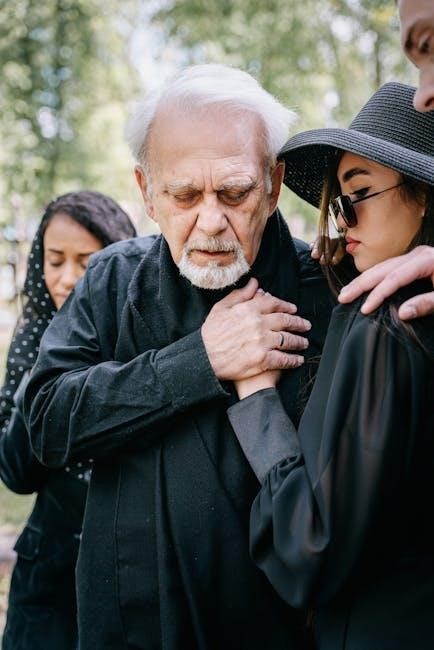
Overview of the Mourners Kaddish
The Mourners Kaddish is a traditional Jewish prayer recited during periods of mourning and on the anniversaries of a loved one’s passing․ It is typically recited in the presence of a minyan (a quorum of 10 men) and is an integral part of Jewish mourning rituals․ The prayer is written in Aramaic and is recited at the conclusion of prayer services, as well as during other specific occasions․ Its purpose is to affirm faith in God and to celebrate the sanctification of God’s name, even in the face of loss․ The Kaddish is not a lament but rather a declaration of trust in divine providence․ It is recited by mourners for a period of 11 months after a loved one’s passing and annually on the yahrzeit (anniversary of the death)․ The prayer is also recited during the shiva and sheloshim periods, making it a cornerstone of Jewish bereavement customs․
Purpose of the Mourners Kaddish
The primary purpose of the Mourners Kaddish is to honor and sanctify God’s name, emphasizing faith and trust in divine providence, even during times of grief․ It serves as a declaration of acceptance and resilience, helping mourners navigate their loss․ The prayer is not a lament but a celebration of life and a reaffirmation of Jewish beliefs․ By reciting the Kaddish, mourners fulfill a mitzvah (commandment) and contribute to the elevation of the deceased’s soul․ It also provides a sense of community and support, as it is traditionally recited in the presence of a minyan, connecting the mourner to the broader Jewish community․ This practice strengthens both personal and collective faith, offering comfort and spiritual solace during the healing process․
Historical Background of the Mourners Kaddish
The Mourners Kaddish has ancient roots, evolving over centuries as a central prayer in Jewish liturgy․ Its origins trace back to Talmudic times, with the prayer initially linked to Torah study and later adapted for mourning rituals, emphasizing faith and divine praise․
Origins of the Kaddish Prayer
The Kaddish prayer traces its origins to ancient times, with roots in Talmudic-era liturgy․ Initially, it was recited after Torah study and later adapted for mourning rituals․ The prayer, written in Aramaic, emphasizes praise of God and affirmation of faith, serving as a comforting declaration during grief․ Its evolution reflects Jewish tradition’s adaptability, blending ancient texts with emotional resonance․ The Kaddish’s core message of divine praise and hope for redemption has remained consistent, making it a cornerstone of Jewish mourning practices․ Recited in synagogues and homes, it connects mourners to their heritage, fostering healing and spiritual strength during difficult times․
Evolution of the Mourners Kaddish
The Mourners Kaddish evolved from a post-Torah study prayer to a central mourning ritual․ Originally recited after Torah readings, it became associated with bereavement in the Middle Ages․ Its Aramaic text, accessible to common people, emphasized faith and divine praise․ Over time, it incorporated elements reflecting mourners’ emotional needs, blending consolation with spiritual affirmation․ The prayer’s structure remained consistent, but its role expanded to include anniversaries and yahrzeit observances․ Today, it is a comforting ritual, recited in synagogues and homes, helping mourners connect with their faith and community during grief․ Its enduring relevance lies in its ability to adapt while preserving its core message of hope and resilience․

Structure and Content of the Mourners Kaddish
The Mourners Kaddish is a prayer in Aramaic, emphasizing faith and divine praise․ It includes phrases like “Yitgadal vyitkadash shmei raba” and “Oseh Shalom,” seeking comfort and peace, with congregational “Amen” responses․
The Aramaic Text of the Kaddish
The Mourners Kaddish is traditionally recited in Aramaic, a language rooted in Jewish tradition․ The prayer begins with the words יִתְגַּדַּל וְיִתְקַדַּשׁ שְׁמֵהּ רַבָּא (“Yitgadal vyitkadash shmei raba”), which means “May His great Name be exalted and sanctified․” This opening line sets the tone for the prayer, emphasizing divine praise and reverence․ The text continues with phrases like בְּעָלְמָא דִּבְרָא כִרְעוּתֵּהּ (“B’olmo dibra kir’uteh”), highlighting God’s creation and will․ The prayer concludes with עֹשֵׂה שָׁלוֹם (“Oseh Shalom”), a Hebrew phrase seeking peace․ The Aramaic text is central to the Kaddish, reflecting its historical and liturgical significance in Jewish mourning rituals․
English Transliteration of the Kaddish
The English transliteration of the Mourners Kaddish provides an accessible way for those unfamiliar with Aramaic to recite the prayer․ It begins with Yitgadal vyitkadash shmei raba, which translates to “May His great Name be exalted and sanctified․” The transliteration continues with balma di vra khirutei, meaning “in the world that He created as He willed․” This system allows mourners to pronounce the words accurately, maintaining the prayer’s traditional integrity․ The transliteration is often provided in PDF formats, such as the Mourners Kaddish transliterated․pdf, making it easier for individuals to recite the Kaddish during services or private moments of remembrance․ This tool is invaluable for preserving the prayer’s authenticity while accommodating diverse linguistic backgrounds․
English Translation of the Kaddish
The English translation of the Mourners Kaddish offers a meaningful interpretation of the Aramaic text, allowing mourners to connect with the prayer’s spiritual essence․ It begins with “May the great Name of God be exalted and sanctified,” reflecting the prayer’s central theme of glorifying God․ The translation continues, “In the world that God created according to His will,” emphasizing divine sovereignty․ It concludes with a hopeful declaration: “May God’s great Name be blessed forever and to all eternity;” This translation captures the prayer’s emotional depth, providing comfort and a sense of continuity for those in mourning․ The English version is often included in Mourners Kaddish PDF resources, making it accessible for recitation during services or private reflection․

Significance in Jewish Tradition
The Mourners Kaddish holds profound significance as a declaration of faith and a celebration of life, providing comfort to those grieving․ It honors the deceased while seeking spiritual healing and reaffirming God’s sovereignty, making it a cornerstone of Jewish mourning rituals․
Role in Mourning Rituals
The Mourners Kaddish plays a central role in Jewish mourning rituals, recited during the initial mourning period, known as shiva, and continued for up to a year after burial․ It is traditionally recited at the conclusion of daily prayer services, emphasizing the mourner’s connection to the community and faith․ The prayer is not about death but serves as an affirmation of life and divine sovereignty, offering comfort and spiritual solace․ Recited in the presence of a minyan (a quorum of 10 men), it fosters a sense of communal support and shared responsibility․ The Kaddish also marks the anniversary of a loved one’s passing, known as yahrzeit, ensuring their memory is honored annually․ Its structure, in Aramaic, includes congregational responses like “Amen,” creating a unifying experience for mourners and the community alike․
Emotional and Spiritual Impact
The Mourners Kaddish holds profound emotional and spiritual significance, offering comfort to those grieving․ It provides a structured way to process loss, connecting mourners to their faith and community․ The prayer’s focus on affirming life and divine sovereignty helps shift perspective from death to the celebration of existence․ Reciting the Kaddish fosters a sense of spiritual solace, reinforcing faith and resilience․ Its communal nature, requiring a minyan, emphasizes shared support and collective healing․ The repetition of the prayer during mourning and on anniversaries creates a sense of continuity and enduring memory․ By reciting the Kaddish, mourners find strength in tradition and a meaningful way to honor their loved ones, bridging grief with spiritual renewal and hope․

When and Where the Kaddish is Recited
The Mourners Kaddish is recited during the mourning period, on the anniversary of passing (yahrzeit), and in synagogue services․ It is part of daily prayers and requires a minyan․
During the Mourning Period
The Mourners Kaddish is recited during the initial year following the loss of a loved one, as well as during the shiva and shloshim periods․ It is traditionally recited daily in the presence of a minyan (a quorum of 10 men) during the three daily prayer services: Shacharit (morning), Mincha (afternoon), and Maariv (evening)․ The prayer is also recited at the conclusion of funeral services and during memorial ceremonies․ Its recitation is a way to honor the deceased and find comfort in communal worship․ The Kaddish serves as a declaration of faith and a celebration of life, emphasizing the belief in a higher purpose amidst grief․ Its structure includes Aramaic text, such as “Yitgadal vyitkadash shmei raba,” followed by congregational responses like “Amen․” This practice provides solace and spiritual connection for mourners during their period of bereavement․
On the Anniversary of Passing
The Mourners Kaddish is also recited annually on the yahrzeit, the Hebrew anniversary of a loved one’s passing․ This tradition honors the deceased and provides a meaningful way to remember them․ The prayer is typically recited during the three daily services (Shacharit, Mincha, and Maariv) on the yahrzeit, often in the presence of a minyan․ It serves as a way to reconnect with the deceased and reaffirm faith in God’s plan․ The Kaddish’s Aramaic text, such as “Yitgadal vyitkadash shmei raba,” is central to this observance․ Reciting the Kaddish on the yahrzeit ensures the deceased’s memory is cherished and their legacy lives on․ This practice offers comfort and continuity for those remembering their loved ones․
In Synagogue Services
The Mourners Kaddish holds a central place in synagogue services, particularly during the three daily prayers: Shacharit (morning), Mincha (afternoon), and Maariv (evening)․ It is traditionally recited at the conclusion of these services, serving as a powerful communal affirmation of faith․ The prayer is led by mourners or those observing a yahrzeit, often standing before the congregation․ The Aramaic text, such as “Yitgadal vyitkadash shmei raba,” is chanted aloud, with the congregation responding with “Amen․” This collective recitation strengthens the sense of community and support for those in mourning․ The Kaddish in synagogue services also underscores the importance of prayer in Jewish tradition, providing a moment of reflection and connection to the divine․ Its inclusion in daily worship highlights its enduring significance in Jewish liturgy and communal life․
Translations and Interpretations
The Mourners Kaddish is available in various translations, including Aramaic, English, and Farsi, ensuring accessibility for diverse communities․ Personal interpretations, like David Hodgson’s version, offer unique perspectives․
Available Translations of the Kaddish
The Mourners Kaddish is widely available in multiple languages to accommodate diverse communities․ The traditional Aramaic text remains the most common, but English transliterations and translations are also popular, making it accessible to those unfamiliar with Aramaic․ Additionally, translations in Farsi and other languages ensure global accessibility․ Personal interpretations, such as David Hodgson’s version, offer unique perspectives on the prayer’s meaning․ These translations are often provided in PDF formats, allowing mourners to easily download and recite the Kaddish during Jewish mourning periods․ This diversity of translations ensures the Kaddish remains a unifying and meaningful practice across cultures and languages․
Variations of the Kaddish Prayer
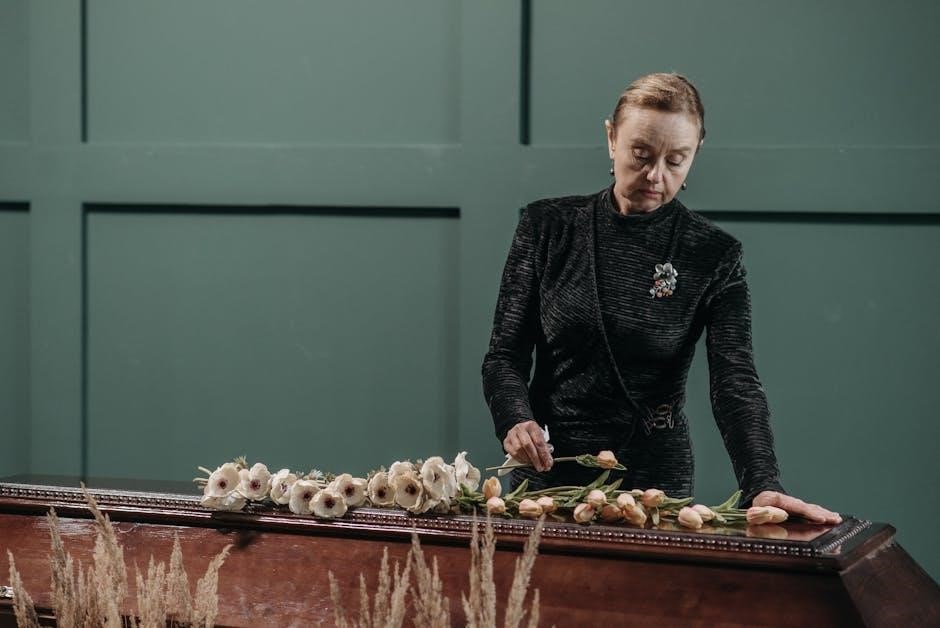
The Kaddish prayer exists in several forms, including the Mourners Kaddish and Rabbis Kaddish, each serving distinct purposes in Jewish tradition․ While the core message remains consistent, variations allow for diverse expressions of faith and mourning across different communities and occasions․
Other Types of Kaddish
Beyond the Mourners Kaddish, there are several other forms of the Kaddish prayer, each serving unique purposes in Jewish liturgy․ The Rabbis Kaddish is recited after Torah study, while the Half Kaddish is used to separate sections of the prayer service․ The Complete Kaddish and Kaddish Shalem are longer versions, often recited by the prayer leader․ Additionally, there is a Kaddish for the anniversary of a loved one’s passing, known as Kaddish Yasom․ These variations maintain the core themes of praising God and affirming faith but are tailored to specific contexts and rituals․ Understanding these differences enriches one’s appreciation of the Kaddish’s role in Jewish tradition and practice․
How to Download the Mourners Kaddish PDF
Visit trusted Jewish learning websites like MyJewishLearning or author-specific sites to download the Mourners Kaddish PDF․ It includes the Aramaic text, English transliteration, and translation for recitation․
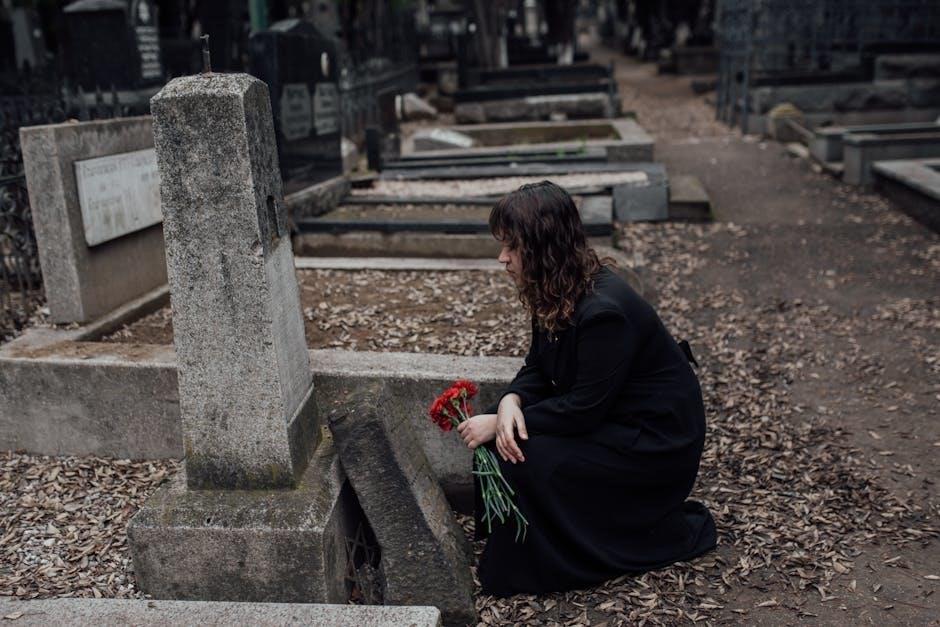
Finding the Mourners Kaddish PDF
To find the Mourners Kaddish PDF, visit reputable Jewish educational websites such as MyJewishLearning or author-specific platforms․ These resources offer free downloads of the prayer in various formats, including Aramaic text, English transliteration, and translation․ The PDF typically includes the traditional version of the Kaddish, along with interpretations and guidance for recitation․ Some websites also provide audio recordings to aid in proper pronunciation․ Ensure you download from trusted sources to maintain accuracy and authenticity․ The PDF is designed to assist mourners in fulfilling their obligation to recite the Kaddish during the mourning period or on the anniversary of a loved one’s passing․
Tips for Recitation
When reciting the Mourners Kaddish, ensure you are in the presence of a minyan (10 men) as tradition requires․ Stand during the recitation and face the Ark in the synagogue․ Understand the meaning of the words to connect emotionally and spiritually․ Practice the pronunciation beforehand, especially since the prayer is in Aramaic․ Focus on the affirmation of faith and the celebration of life․ Recite clearly and with intention, allowing the words to convey comfort and strength․ Listen to recordings if needed to master the melody and rhythm․ Maintain a steady tone and avoid rushing․ Remember, the Kaddish is not just a mourning ritual but a declaration of faith and hope․
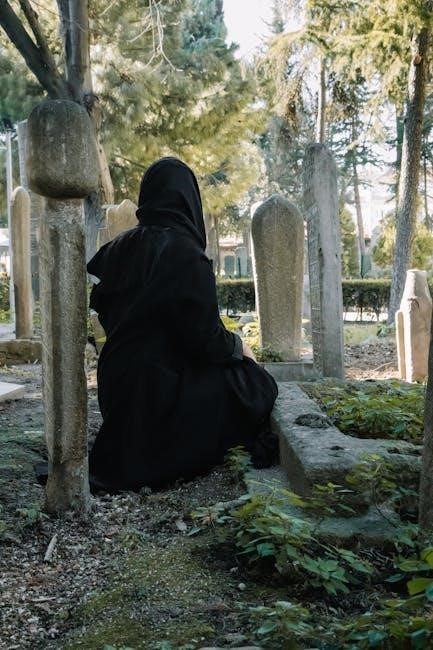
Common Questions About the Mourners Kaddish
Why is the Kaddish recited? Who can recite it? Is it only for mourning? These questions highlight its purpose as a declaration of faith and comfort during grief․
Addressing Misconceptions
A common misconception is that the Mourners Kaddish focuses on death, but it is actually a celebration of life and faith․ Many believe it is mournful, yet it praises God’s greatness․ Another misconception is that only the bereaved can recite it, while in reality, the community’s participation is vital․ Some think it is in Hebrew, but it is primarily in Aramaic․ Additionally, it is not just for mourning but also for affirming faith and finding comfort․ Understanding these aspects helps in appreciating the prayer’s deeper significance and its role in Jewish tradition․
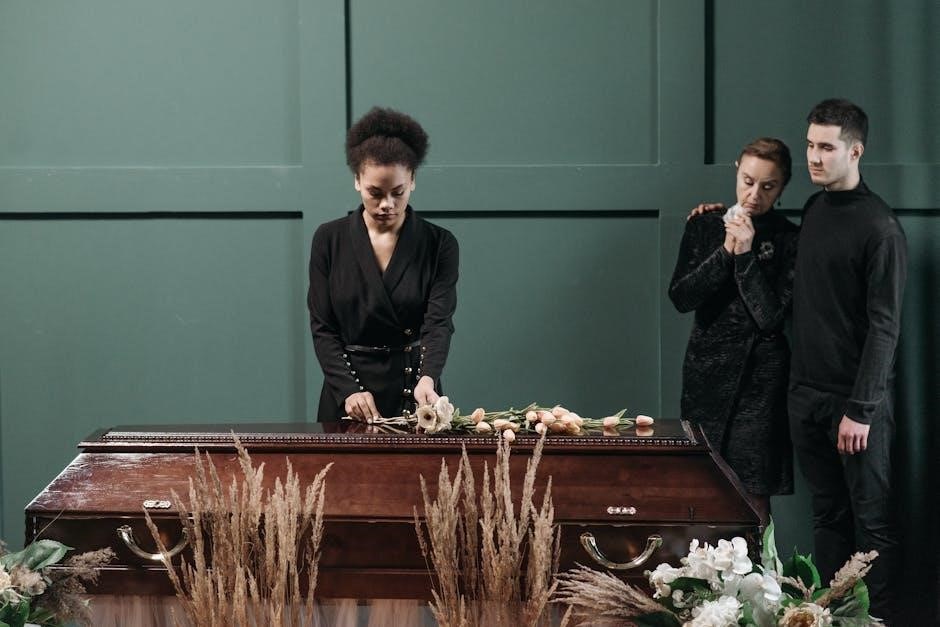
Recitation Tips and Guidance
Reciting the Mourners Kaddish requires attention to tradition and emotional focus․ Ensure you are in the presence of a minyan (10 men) for validity․ Practice the Aramaic text beforehand to maintain fluency and respect․ Stand during recitation and face the Ark in the synagogue․ Encourage the congregation to respond with “Amen” to create a sense of community․ Focus on the prayer’s meaning, emphasizing faith and comfort․ Avoid rushing; recite clearly and with intention․ Emotional authenticity enhances the experience, connecting you to the deceased and the community․ Use a Mourners Kaddish PDF for accurate text and transliteration․ Remember, the Kaddish is not just a ritual but a heartfelt expression of faith and remembrance․

Resources and Further Reading
Access the Mourners Kaddish PDF online for accurate recitation․ Visit websites like harsinai․org or myjewishlearning․com for detailed guides, translations, and insights into its significance․
Online Sources for the Kaddish
Several online platforms provide access to the Mourners Kaddish in PDF format, along with translations and guides․ Websites like myjewishlearning․com and harsinai․org offer detailed resources, including the Aramaic text, English transliterations, and translations․ Additionally, platforms such as bimbam․com and chabad․org provide audio recordings and instructional videos to aid in proper recitation․ These sources are invaluable for those seeking to honor their loved ones through the traditional mourning rituals․ They ensure accessibility and accuracy for individuals reciting the Kaddish during shiva, shloshim, or on the yahrzeit․





